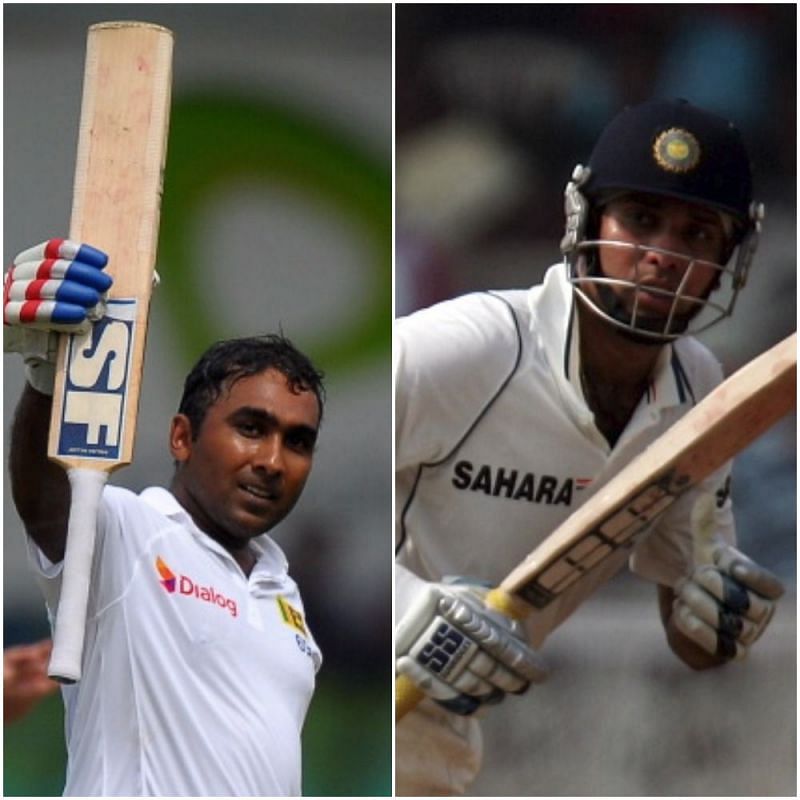
VVS Laxman vs Mahela Jayawardene: A statistical comparison
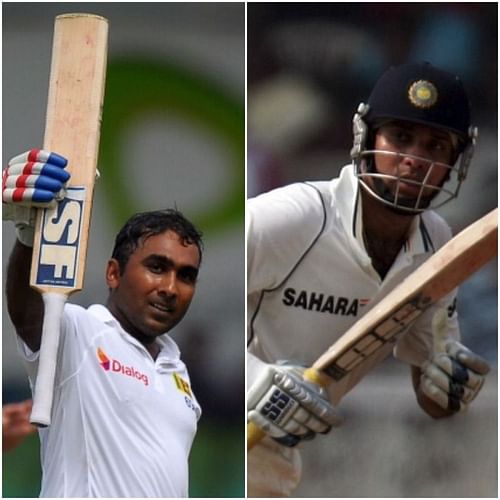
With soaring expectations and a world full of dreams, most individuals strive to make a mark when they enter a particular field. Hoping to carve their own unique identity amidst a horde of contemporaries, each person begins their quest towards stardom with a renewed zeal.
Unfortunately, the horrors of reality very soon result in an unanticipated decline. Unable to cope, many falter, witnessing the dark and murky side of events. The few who do manage to establish themselves linger on for millenniums as heroes.
The sporting arena too does not remain devoid of this plethora of contrasts. Debuts made and debuts forgotten. Plagued by inconsistency and pressure, most cricketers remain cast in the shadows after the initial euphoria of promise. Very, very few stay on. Very few stamp their authority.
Mahela Jayawardene and VVS Laxman. Caught up amidst more famed and respected players, the two silently started piling on runs at will, forcing one and all to notice the phenomenon that they could turn out to be. Bullying rivals on home soil and pinching them overseas, the duo, through their exploits, thrust themselves into the league of the finest players ever to have played the game.
Laxman and Jayawardene: true gentlemen that played the ‘gentleman’s game’
Debuting less than a year within each other, Laxman played his first Test match against South Africa in Ahmedabad in November 1996, with Jayawardene playing his maiden Test in August 1997. When India toured Sri Lanka, the two players had almost similar starts to their international careers, notching up their first fifties in their very first match.
While Laxman scored 51 in the second innings, Jayawardene notched up 66 in the historical game in Colombo in which Sri Lanka stitched up 952/6. Cashing in on their impressive debuts, the duo, through their consistent performances and match-winning knocks, soon stamped their authority in Test cricket and transformed into integral members of their respective Test teams.
Also read: Sourav Ganguly vs Graeme Smith: A statistical comparison
A look at the overall Test figures of Laxman and Jayawardene shows the calibre of the two players, who soon became the faces of Test cricket the world-over.
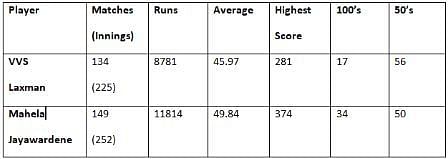
Laxman had his best years on the circuit from 2000 to 2003, averaging in excess of 50 in four seasons. 2003 was his breakthrough year, when he averaged 85 in five matches. After a slight blip in 2004, Laxman was back to his best, averaging above 40 till 2012. In 2009 and 2010, he played 17 Test matches, scoring three Test centuries and more importantly, 12 half-centuries. Batting lower down in the order, the feats were impressive indeed.
Jayawardene, on the other hand, averaged above 40 constantly from 1998 to 2010. The three year period from 2007 to 2010 can be termed his Golden Era, in which he averaged 98.20, 65.50 and 62.84 respectively. 11 centuries in this phase with an astonishing conversion rate saw him pile on the runs at will. He became only the ninth batsman to touch the magical figure of 10,000 Test runs, in 2011. He suffered a slight dip in form in the years preceding his retirement in 2014, which impacted his overall average.
Numbers according to their batting position

The real hallmark of a batting mainstay remains the ability to adapt to all kinds of situations. Moulding your batting according to the ever-changing demands of the team and batting in a position away from your comfort zone separate the legendary from the ordinary.
The duo shifted their style of play with aplomb as and when the team desired them to.
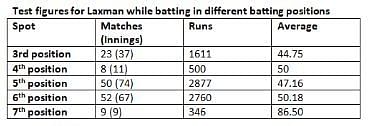
Even though Laxman spent most of his Test career batting at either number 5 or 6, he did not falter when he was pushed higher up the order. He even opened the innings on 16 occasions. His highest score of 281 against Australia came when the Hyderabadi was batting at number 3. However, over the years, he made the lower middle order his own, racking up tough runs with the tail and guiding India to memorable victories or face-saving draws in the toughest of conditions.

Test figures for Jayawardene while batting in different positions
Jayawardene, unlike Laxman, batted in the top-4 for a majority of his career till his retirement in 2014. His highest score in the Test arena - 374 against South Africa came in the number 4 position.
Making a particular spot one’s own, yet not hesitating to bat anywhere according to the team’s ever-changing demands, define a true legend of the game and this was displayed by the mavericks from Sri Lanka and India.
Performance in different conditions: a reflection of their abilities
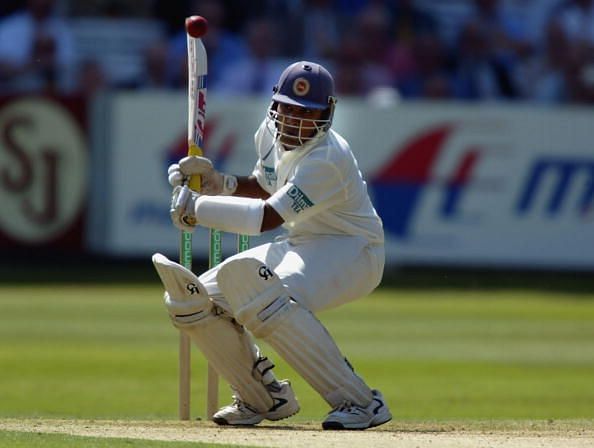
It is no secret that the cricketing fraternity keenly observes and judges a cricketer’s skill according to his performances in unfamiliar and alien conditions.

The above figures reveal Jayawardene’s surprisingly average performances in conditions away from home. Out of his 34 hundreds, only two have been scored in England and one each in Australia and New Zealand. In India, his average soars to 62.80 which is way above his average of 52.45 in Sri Lanka.
Laxman took a strange liking to the Australian bowling attack, which can be highlighted from the fact that four out of his six centuries against them were scored Down Under, at an average of 44.14. Although he had no century in South Africa, four half-centuries in 18 innings that saw him amass 566 runs ensured that his average against the Proteas in South Africa was more than his overall average against them, which stands at 37.53.
His average in India is above 50 and he averaged above 40 in all nations that he toured, except England, Pakistan and Bangladesh.
Contribution as the Test progresses
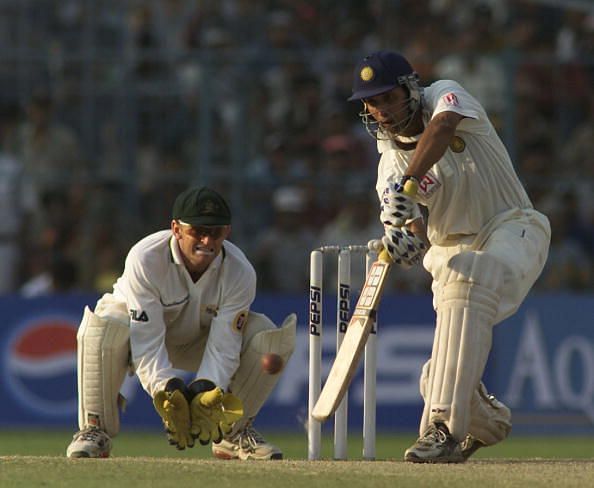
A Test match remains the holy grail for all cricketers due to the diverse challenges and obstacles that each innings presents. Unless the conditions are doctored or there is a burst of spirited bowling, the first two innings are usually considered the best for batting, while it is in the last two innings that a player’s mettle and stamina are tested.
With the pitch usually favouring the bowlers and immense pressure, a performance in such situations usually distinguishes the mortals from the greats. Plodding along with an inspired show of determination when the team has its back to the wall in either the third or the fourth innings gives a fair indication of the grit within a player.


While Jayawardene is leaps and bounds ahead of Laxman in the first innings, with an average of 60.13 against Laxman’s 44.25, the Indian averages higher in the second innings. His average of 48.88 is much better than Jayawardene’s average of 33.64 when the team is batting second. Laxman’s strike-rate of 50.06 is also a touch higher than the Sri Lankan's 45, though both scored five centuries each.
While India had the likes of Sachin Tendulkar and Sourav Ganguly, who made their mark when their team was batting first, they often failed to replicate their heroics in the third or fourth innings. Laxman averages more than both of them when the team was batting for the second time and he, along with Dravid, gave India much-needed balance in the Test squad.
Contribution in wins and draws
The biggest factor that separates a true legend from just a good player is his exploits in winnings causes. Jayawardene’s 17 hundreds in winning causes are the total number of centuries that Laxman scored in his entire career!

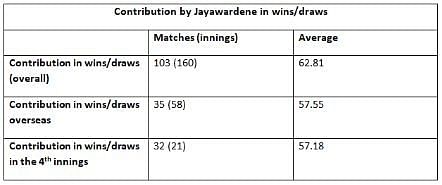
15 of Laxman's 17 Test hundreds have come in wins or draws, out of which seven have been scored away from home. Jayawardene, on the other hand, has scored 29 of his 34 centuries in either a win or a draw.
In the fourth innings, Laxman averages an astonishing 73.80 in overseas wins or draws, which goes up to 100.66 in successful or drawn Test matches at home. In the fourth innings of an overseas Test match that has either been won or drawn, Jayawardene’s average drops to 32.66 which otherwise stands at 86.60 at home.
Both Laxman and Jayawardene were defined by acute temperaments and shrewd understanding of the game. By scripting innumerable triumphs for their nations for well over a decade, they helped usher in a new era in Test cricket.
Final verdict
While one player took on the responsibility earlier on in the team’s innings, the other managed the hard task of playing with the tail.
Criticising a player or judging them based on pure numbers is highly antagonistic for it does not take into account the pitches on offer nor does it consider the form of a particular bowler. Their impact can be witnessed by the high regard that the fans of both India and Sri Lanka hold them in.
Many players have emerged - some to flourish and others to fade away even before their heydey - but very few have managed to bring back a queer sense of nostalgia which is something that both Laxman and Jayawardene achieved. In that lies their unadulterated legacy.